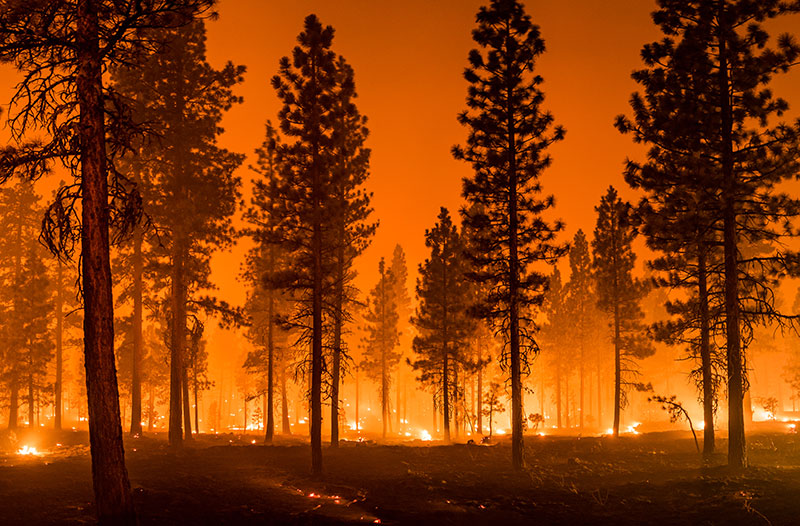by Stephen C. Mason, Jr., Ph.D., Assistant Professor of Biology
It’s not a surprise anymore when we hear about another uncontrollable wildfire that is raging somewhere in the world. These stories often come from the western United States, but now, we are even hearing that the boreal forests of Canada and the tropical rainforests in Brazil are dealing with wildfires too. This might seem counterintuitive—how can a damp and cold forest in Canada and a wet and humid place like the tropics be on fire? Well, the short answer is anthropogenic, or human-driven, global warming. With an increase in the average global temperature, there’s also an increase in evaporation, earlier snowmelt, and more rain-free days. These factors all contribute to more extreme droughts, thus an increase in wildfire frequency and severity.
Wildfires often have a bad reputation, particularly when publicized through the media. Wildfires take human lives, burn properties and pollute the air with harmful emissions. As kids, most of us were taught Smokey Bear’s catchphrase, “Only YOU can prevent wildfires!”—implying that wildfires are bad. Furthermore, the post-fire environment isn’t exactly aesthetically pleasing to us either. More times than not, the fire leaves (what looks like) a desolate, charred, wasteland that’s devoid of life and vegetation. Therefore, it’s completely understandable why there’s so much dislike of wildfires.
However, it’s important to mention that wildfires are a natural type of disturbance. This means that every terrestrial ecosystem has naturally had wildfires throughout its evolutionary history. These naturally occurring wildfires have driven thousands of plant and animal species to adapt to and even depend on fires. In fact, fire-dependent species (aka pyrophilic species) are actually some of the most endangered species in the world and need fires to survive and thrive. The unnatural activity of fire suppression, in which humans are actively trying to prevent and eliminate wildfires, is one of the leading threats to overall biodiversity in terrestrial ecosystems.
Keep in mind that higher biodiversity usually means a healthier ecosystem. For example, a natural forest in the Poconos will have a significantly higher amount of biodiversity than Philadelphia, simply because there are more native plant and animal species that live there. One of the major positive effects of wildfires is that they create change in terrestrial habitats that can increase biodiversity. Even though there are plenty of dead trees after a wildfire, those same dead trees create more habitat for owls and woodpeckers to nest in. Additionally, thousands of insect species need deadwood for shelter, food and reproduction. Some insect species even have “smoke detector” organs that attract them to fires to help them find potential mates. Many species of plants won’t even sprout until after a fire, since there will be an increase in sunlight in the freshly burned habitat and an abundance of nutrients in the soil. Wildfires also reduce competition between plant and animal species, which readily helps less competitive species exploit new resources and thrive. Without fires, we wouldn’t have heterogenous landscapes, which can provide a variety of habitats, new resources and reduced competition, which all directly lead to healthier ecosystems.
Thus, wildfires aren’t all bad, nor are they all good. Wildfires are just necessary. There will always be “winners and losers” with every natural disturbance. Unfortunately, humans are biased against wildfires, since we are typically the losers after they occur. However, wildfires indirectly help us by keeping ecosystems healthy. They shift species compositions between freshly burned and unburned habitats to maintain and increase biodiversity. A common myth in ecology is that there’s a steady state where all organisms are in balance with each other and the environment (equilibrium). In reality, though, the normal and natural condition for an ecosystem is to be constantly recovering from the last disturbance, such as wildfires. However, because of global warming, the new hot topic in disturbance ecology is if wildfires can still be considered “natural.” Stay tuned.






